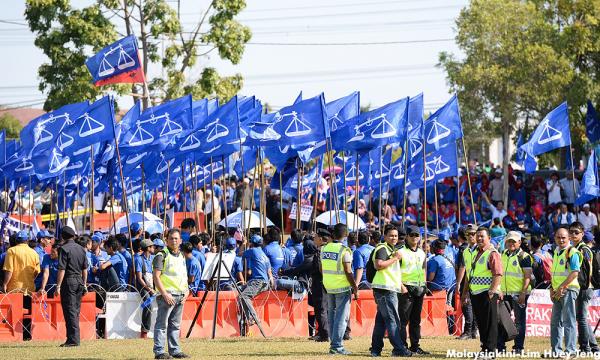MP SPEAKS | My colleague and Member of Parliament for Kluang, Liew Ching Tong, has been discussing the possibility of a Malay tsunami in the upcoming 14th general election which will allow Pakatan Harapan to win power at the federal level.
DAP parliamentary leader Lim Kit Siang has written about a 10 and 5 formula whereby a swing of 10 percent against the BN by Malay voters and a swing of 5 percent by non-Malay voters would enable Harapan to win 113 out of 165 parliament (or 68 percent of seats) seats in Peninsular Malaysia thereby paving the way for Harapan to get to Putrajaya.
How much of a Malay swing against the BN is needed for Harapan to win Putrajaya? Is a Malay tsunami in the form of a 15 percent Malay vote swing against the BN something realistic?
To answer the question of whether a 15 percent Malay vote swing against the BN is a realistic projection in GE14, we must examine vote swings among another voting "blocks" in previous general elections in Malaysia.
Table 1 below shows the estimated support for the BN by racial group and changes in racial support for the BN from 1995 to 2013.

From Table 1, there has been one instance of a more than 15 percent swing in the Malay support against the BN which was during the 1999 Reformasi election where BN’s support among the Malays fell by 27 percent from 81 percent in 1995 to 54 percent in 1999.
PAS emerged as the largest opposition party in parliament after the 1999 general elections. The loss of support by the BN was felt most in the northern states of Kedah, Teregganu, and Kelantan where PAS won most of its parliament seats.
What saved BN in the 1999 GE was its high level of support among non-Malay voters. The Chinese support for the BN increased by an estimated 10 percent, from 55 percent in 1995 to 65 percent in 1999. The Indian support for the BN remained high at over 90 percent.
In the 2004 GE, the Malay support for the BN rebounded somewhat when it increased by 11% percent from 54 percent to 65 percent. The BN support among the Chinese increased by a further 10 percent to an estimated 75 percent, one of the highest levels in Malaysian history. This was the Pak Lah tsunami effect which allowed the BN to capture 91 percent of parliament seats.
In the 2008 GE, the BN suffered a tremendous drop in its non-Malay support. BN support among the Chinese voters fell by 40 percent (from 75 percent to 35 percent) while BN support among the Indian voters, mostly because of the Hindraf movement, fell by at least 42 percent (from more than 90 percent to 48 percent). BN support among the Malays fell by a smaller amount, from 65 percent to 59 percent, a drop of only 6 percent.
In the 2013 GE, BN support among the Malays increased slightly, by 5 percent, from 59 percent to 64 percent while the BN support among the Chinese and Indians fell by a further 21 percent and 10 percent respectively to 14 percent and 38 percent.
To go back to the initial question, how much of a Malay swing can we expect in GE14? A Malay swing of 10 percent is not out of the question given the impact of Dr Mahathir Mohamad and the formation of Parti Pribumi Bersatu Malaysia (Bersatu) and later on, the creation of Harapan which includes Bersatu.
With a historically unpopular prime minister, the 1MDB scandal, and the impact of the GST and rise in the cost of living, the Malay vote is likely to swing against the BN in GE14.
A Malay swing against the BN of 15 percent would bring BN’s Malay support to about 50 percent which would leave BN teetering on a knife’s edge. A swing of 15 percent or more in any voting block doesn’t usually occur but we are living in unusual circumstances. It happened in 1999 among the Malay voters and it happened again in 2008 among the non-Malay voters.
If I had been told in 2013 that Mahathir and Muhyiddin Yassin would form a new political party to fight Umno in GE14, I would have said that you were out of your mind. And yet, what was then unthinkable is now a reality. As unlikely as a 15 percent swing may sound, it is not out of the realm of impossibility.
Of course, if there is a 15 percent swing in the Malay vote against the BN, the next question we have to ask is how much of this swing would go to Harapan and how much of this would go to PAS?
To answer this question would require another article.
ONG KIAN MING is the MP for Serdang.



